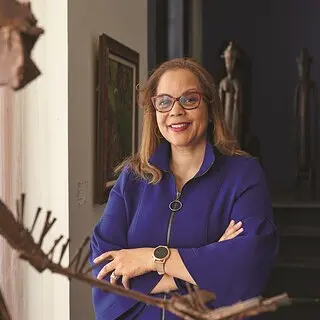
Q&A with Monique Brinkman-Hill, Executive Director of Chicago's South Side Community Art Center
As an active board member of the South Side Community Art Center, Monique Brinkman-Hill knew the legacy of the 81-year-old Chicago institution. And when she was appointed executive director in December of 2019, she was looking to make some history herself by adding new luster to the 129-year-old mansion at 3831 S. Michigan Ave. that served as a way station for 20th–century Black artistic luminaries such as Gordon Parks, Gwendolyn Brooks, and Charles White. But within five months of Brinkman-Hill taking the big chair, the COVID-19 pandemic struck. We spoke recently with the art collector and former financial services executive.
We’re a year into the pandemic. How is the center adjusting?
Like every other organization, this center had to do a lot of pivoting to adjust to the pandemic. We were closed totally for several months [and] figured out a way to operate virtually, and we’re still working toward continuously improving that. We’ve had several exhibits where we’ve done timed events … limited entry for half-hour increments, up to six people at a time. And this is certainly not optimal, but it has allowed us to still have people come in. People have been very receptive to the fact that, you know, they can actually see art.
You’re also looking to expand outdoor programming?
We have a lot to the north and [another lot that was donated by a nearby church]. We’re hoping to do some fun things with that, because there’s a lot of artists that work outside. There’s a lot of programming that we can do [with] that additional capacity.
And you launched a new website in February?
I’m super excited about that. We wanted to launch [out of] appreciation and respect for Black History Month. And certainly with our 80 years of history in the Black art community, it made a lot of sense. The people who are artists, and the community stakeholders and those who have a passion for art—they’ve known about us [and] continue to support us. But there are so many people who haven’t had a chance to be introduced to the South Side Community Art Center and the rich history and the number of individuals who’ve come through the doors who have been instrumental.
You’re located in the city’s legendary Bronzeville. How did that history shape the center?
So you think about this: In 1940, a group of artists came together and they recognized the need to have a place to gather. They recognized the importance. You’re talking about a time that was very difficult for African Americans to navigate. And so this location became the place [where] Gordon Parks had a darkroom in the basement. [You also have] Charles White and [artist and founder of Chicago’s DuSable Museum of African American History] Dr. Margaret Burroughs. There’s so much rich history. I learn something new every day. I learned [artist] Kerry James Marshall had his wedding there. And they say Nat King Cole used to come play, when he was in town, on the [center’s] piano. Where else do you have that?
I understand you’re raising money and are awaiting a $2 million rehab grant from the state as well as some city funding.
We really want to bring in an HVAC system, improvements to our bathrooms, roof repairs—ADA, in terms of access and allowing more people to come in using an elevator. You know, $2 million is an incredible gift, but you have to make sure you’re using it in a very judicious way because everything is so expensive. For a building of that age, you have to continuously work toward improving the [building] envelope so that there’s no water damage. Our building is in need of some love, and what I’m hoping is that these grants will be able to help us live on another 80 years in that same location.
How important is it that the South Side Community Art Center—both the building and the programming—survives?
This is about owning our history, claiming our history, sharing our history. You know, when I think about our community and I think about how many individuals don’t know how deep and rich our true history is, that’s what this means to me.
In June of 2019, participants in the National Trust’s HOPE Crew program helped clean the South Side Community Art Center’s brick-and-limestone facade. The site’s historic windows were also restored in 2019 using a grant from the National Trust’s African American Cultural Heritage Action Fund.
Donate Today to Help Save the Places Where Our History Happened.
Donate to the National Trust for Historic Preservation today and you'll help preserve places that tell our stories, reflect our culture, and shape our shared American experience.


